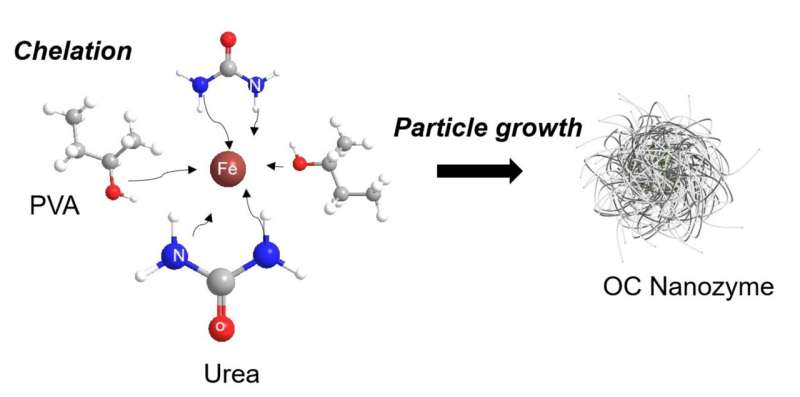November 7, 2025 | 00:36 GMT +7
November 7, 2025 | 00:36 GMT +7
Hotline: 0913.378.918
November 7, 2025 | 00:36 GMT +7
Hotline: 0913.378.918
Now, researchers from the University of Illinois Urbana-Champaign have developed a nanozyme that is organic, non-toxic, environmentally friendly, and cost effective.

Illustrated Conceptualization of the OC nanozyme. Credit: Nanoscale (2023). DOI: 10.1039/D3NR02025H
In a newly published paper, they describe its features and its capacity to detect the presence of glyphosate, a common agricultural herbicide. Their goal is to eventually create an user-friendly test kit for consumers and agricultural producers.
"The word nanozyme is derived from nanomaterial and enzyme. Nanozymes were first developed about 15 years ago, when researchers found that iron oxide nanoparticles may perform catalytic activity similar to natural enzymes (peroxidase)," explained Dong Hoon Lee, a doctoral student in the Department of Agricultural and Biological Engineering (ABE), part of the College of Agricultural, Consumer and Environmental Sciences (ACES) and The Grainger College of Engineering at U. of I.
These nanozymes mimic the activity of peroxidase, an enzyme that catalyzes the oxidation of a substrate by using hydrogen peroxide as an oxidizing agent. They provide higher stability and lower cost than natural peroxidase, and they are widely used in biomedical research, including biosensors for detection of target molecules in disease diagnostics.
"Traditional nanozymes are created from inorganic, metal-based materials, making them too toxic and expensive to be directly applied on food and agriculture," Lee said.
"Our research group is pioneering the development of fully organic compound-based nanozymes (OC nanozymes) which exhibit peroxidase-like activities. The OC nanozyme follows the catalytic activity of the natural enzyme but is predominantly based on agriculture-friendly organic compounds, such as urea acting as a chelating-like agent and polyvinyl alcohol as a particle stabilizer."
The researchers also implemented an optical sensing system integrated with the OC nanozyme for target molecule detection. Colorimetric assays, one type of optical sensing methods, use color intensity to provide an estimated concentration of the presence of specific molecules in a substance, such that darker or lighter color indicates lower or higher quantity of target molecules. The organic-compound nanozyme performed on par with nanozymes typically used in biosensing applications within their kinetic profile with molecule detection performance.
"Traditional nanozymes come with a host of issues: toxicity, lengthy degradation, and a complex production process. In contrast, our nanozyme is quicker to produce, cost-effective, non-toxic, and environmentally friendly," said Mohammed Kamruzzaman, assistant professor in ABE and co-author on the study.
Lee and Kamruzzaman applied the OC nanozyme-based, colorimetric sensing platform to detect the presence of glyphosate, a widely used herbicide in the agricultural industry. They performed colorimetric assays in solutions containing varying concentrations of glyphosate, finding the organic nanozyme was able to successfully detect glyphosate with adequate accuracy.
"There is an increasing demand for testing pesticide or herbicide presence in agricultural products to protect human and crop health. We want to develop a OC nanozyme-based, point-of-use testing platform for farmers or consumers that can apply in the field or at home," Kamruzzaman stated.
"People would obtain a test kit with a substance to mix with their sample, then take a picture and use an app on their phone to identify the color intensity and interpret if there is any glyphosate present. The ultimate goal is to make the test portable and applicable anywhere."
The researchers are also working on developing additional nanozymes and envision these environmental-friendly materials as holding great potential for a wide range of applications.
The research is published in the journal Nanoscale.
(Phys)

(VAN) The State of Food and Agriculture 2025 report focuses on land degradation caused by human activities.

(VAN) Brazil on Monday opens three weeks of events linked to the COP30 climate summit, hoping to showcase a world still determined to tackle global warming.

(VAN) The US egg industry has undergone a fundamental decade-long transformation, transforming to a sophisticated, value-added sector primarily defined by the shift to cage-free production, according to a recent analysis by Rabobank.

(VAN) Rice fell to 21,200 won per kilogram in Pyongyang as fresh corn reaches markets and imported grains enter through border cities.

(VAN) Latest Global Forest Resources Assessment provides detailed analyses for 236 countries and areas.

(VAN) Bleak report finds greenhouse gas emissions are still rising despite ‘exponential’ growth of renewables.

(VAN) Europe’s animal welfare overhaul is on life support. Denmark’s farm minister thinks he can still revive it - one compromise at a time.